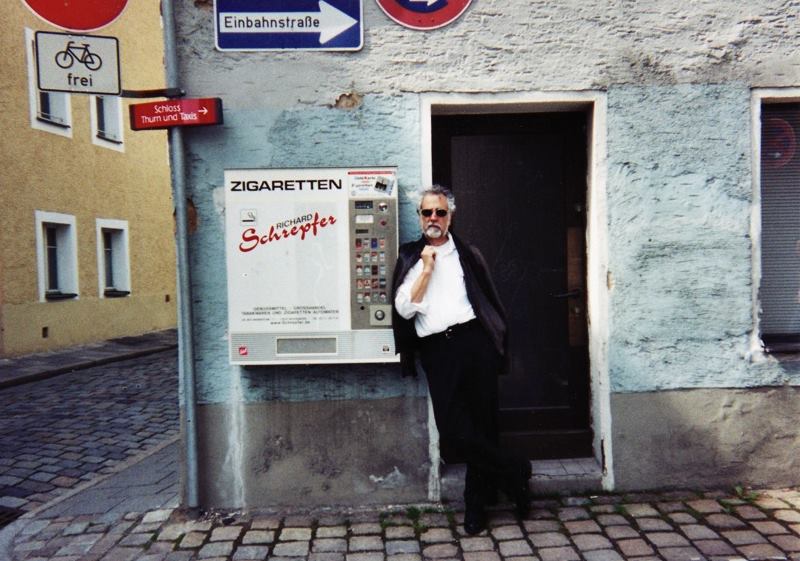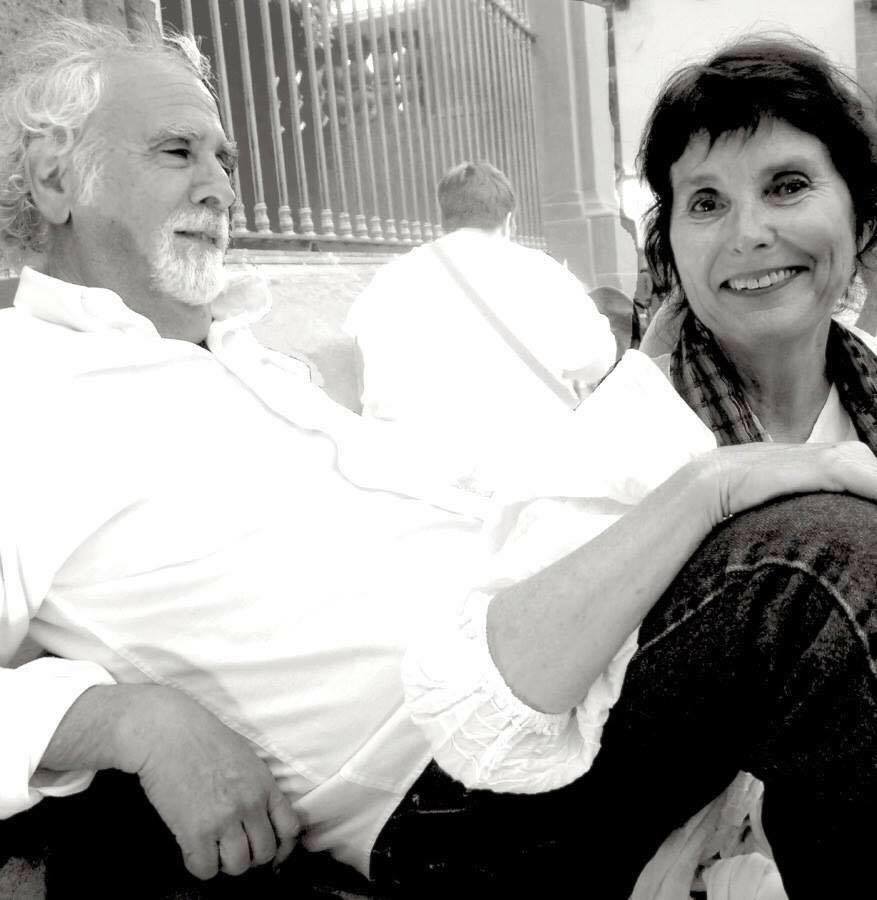
Born Philip Ivan Koplin on September 21, 1942, in Brooklyn, New York, the artist and editor died suddenly of a viral infection of the heart on July 6, 2017, in Santa Barbara, where he had lived for several decades. Philip’s time here fully expressed the promise of a better life that this city has represented for so many. As an artist, activist, husband, grandfather, and friend, he embodied an optimist’s belief in the possibility of second — and third, or even more — chances. Whether Philip was drawing one of his inimitable fuzzy creatures, telling a story to his grandsons, curating an art exhibition, or writing a letter to the editors of the Times Literary Supplement beginning with the classic British salutation “Sir—,” he always committed completely to whatever he was doing.
The original wisecrack at the head of his website: “Minding the gap between intention and achievement,” effectively summarizes Koplin’s aesthetic. The habitual humility he displayed about his work blended gratitude for new opportunities with a deep yearning for more completely satisfying forms of expression. As in the “art brut” movement championed by Jean Dubuffet or the “arte povera” theorized by Germano Celant, Koplin’s seemingly simple style sprang from a desire to capture the unmediated result of authentic creativity. Critic Joe Woodard, who reviewed Koplin’s work many times throughout the years, describes Koplin’s “rough, neo-primitive” drawings and monotypes as “sly, subtle, and deceptively child-like” and sees them as achieving a “murky, mumbly sense of grace.”
His many friends will remember him as half of one of the city’s most talented and influential couples. Like such friends as Dane Goodman and Marie Schoeff or Keith and Fran Puccinelli, Philip and his wife, Virginia McCracken, have given unstintingly of their time and energy to the betterment of the arts in Santa Barbara. Everything that has passed through their hands reflects a common bond they established through sharing their multiple creative pursuits. Finding, noticing, shaping, and sharing their way through life together, Virginia and Philip, who met and married in their fifties, held out the hope to everyone they knew that it’s never too late to discover one’s soul mate.

In an intimate letter of condolence that Virginia shared with me, close friend of the couple Lydia Emard articulated the impact of their late-life marriage: “You made him happy. Radiantly, jubilantly, home-at-last happy. I didn’t even know that was possible.”
Their partnership brought joy not only to Philip and Virginia but also to the children and especially the grandchildren, who found their Grampy to be “a master storyteller” and discovered in him a unique tenderness. Perhaps the most touching of all the quotes collected for this tribute is by grandson Atticus, who told Virginia when he was just 2 years old: “Grammy, you know that Grampy is a very special boy to me.”
Two accounts of Philip’s early life as an editor, a photographer, and a resister of the Vietnam War–era draft have come through from friends Peter Behrens and Vincent Stanley. Stanley praises Philip’s integrity, which he defines as, “for a start, his response to the Vietnam War, his refusal to go and his willingness to pay the price of exile.”
Koplin’s career as an artist began with photos he took of the October Crisis that arose in Montreal over Quebecois independence shortly after he arrived. His skill with a camera came back into use in later years when he shot some wonderful pictures of people enjoying the beach at Coney Island, the Brooklyn neighborhood where he grew up. These photos were eventually exhibited in the Santa Barbara Museum of Art in a show curated by the late Karen Sinsheimer. The Montreal photos found their way to the public through a collaboration with the novelist Peter Behrens for a Canadian publication called the National Post. Behrens remembers his friend as “a quiet man who believed noise in the streets was a healthy discourse. A private man who loved to see public demonstrations, street protests, and people standing up for their rights. A gentle soul and stiff-necked, instinctive Jewish rebel.”
Sullivan Goss, An American Gallery, has scheduled a memorial show called Thank God for Philip Koplin (& Family) that will be on display September 7-October 1. The opening, Thursday, September 7, 5-8 p.m., and an additional time, Sunday, September 10, 3-5 p.m., are set aside as occasions for people to gather in remembrance. The family asks that, in lieu of flowers, donations be made to Planned Parenthood in Philip Koplin’s memory.
Remembering Philip Koplin
by Vincent Stanley
When I read Virginia’s email, and put down the phone in dismay, what popped into mind was, I’ve never known anyone with quite Philip’s integrity. This was not something I’d ever thought before, partly out of respect. You try to meet your friends on their terms, and Philip, so singular and thoughtful, wasn’t keen on broad comparisons or superlatives. I can imagine those eyebrows creeping forward on his mobile face, and the question, raised in a gentle tone: What does that mean?
For a start, his response to the Vietnam War, his refusal to go, and his willingness to pay the price of exile. His choice of a living, as a freelance science editor, for the independence, without ever complaining about the lack of institutional support and absence of colleagues. He was wryly amused by the work that came steadily his way: difficult papers on physics, often, but also process piping, fire alarm signaling, the persistence of sail in the age of steam, the mastering of cardiovascular surgery. He kept his sharpened pencils at hand, had a comfortable place to sit, and what came in the mail he turned around in clearer and better shape, with questions noted in the margins.
The way he became an artist: He liked hanging around his artist friends. They were so much fun. he said, he decided to become one. And damned if he didn’t, in late middle age, make serious business of herding the ephemera of consciousness into things he made by hand and eye. To see his drawings in conte crayon of the invented creatures of his imagining or his assemblages or his muted photographs of centuries-old books on their way to decomposition is to change if only a little the way we see, to open our eyes to something we would not have seen before. His tagline on his website read: “Minding the gap between intention and achievement.” He played in, as well as minded, that gap, and fruitfully during the past 20 years.
This solidly solitary man fell in love and got married when he was well into his fifties. To those who praised him for his courage making such a leap of faith so late in life, he said, “What courage? I can either be miserable the rest of my life or … I can marry Virginia.” He knew a gift when he saw one, accepted it with grace, and tended it, and her, with great heart and gentleness the rest of his days.
Virginia had grown children, Ryland and Amy, and after she and Philip got together grandchildren arrived. He was wonderful with the kids, always himself, whimsical, engaging, attentive, without a trace of condescension. They loved him back: perhaps because he was not a child and had long put away childish things — except a delight in the imagination, a capacity for open affection, and a bent toward j ustice. Godspeed, Philip.
Philip Koplin Memorial
by Peter Behrens
A few days before Philip’s death, I posted about the singer and songwriter Jesse Winchester on Facebook, with a link to Jesse’s wonderful ballad, “Mississippi on My Mind.” Jesse had arrived in Montreal as a draft resistor in the ’60s and eventually become a Canadian citizen. What could be more Canadian, I wrote in my July 1 — Canada Day! — post, than a homesick Memphis native singing about Mississippi’s “angry oven heat” from the frigid depths of Montreal winter?
Philip immediately “liked” that post, as I suspected he would. He had come to Canada — stepping off a Greyhound bus from New York City — at the same time as Jesse Winchester, and for the same reason. Exile became one of Philip’s themes and preoccupations. The beautiful complexity of identities — national, ethnic, religious, spiritual, regional — was another.
Philip retained a fondness for the complicated, mostly French-speaking city that had taken him in as an exile from Coney Island, Brooklyn, and the Vietnam War. The only project we ever collaborated on was publication in a major Canadian daily, The National Post, of a series of Philip’s street photographs taken in Montreal the summer he arrived.
Philip had a camera. Philip had an eye. Philip had an immense curiosity and a streetwise instinct that often led him straight to the heart of things.
Wandering the neighborhoods of Montreal that summer, he was still a Brooklyn boy, a young man who had refused to have anything to do with a war that was wasting hundreds of thousands of human lives, and had chosen exile instead.
Philip knew nothing about the heated tribal politics of Québec in that nationalist era, but somehow his street-level photographs of demonstrations and protests caught the spirit of those times better than any other work I have seen. He was drawn to exactly where the action was.
Philip was a quiet man who believed noise in the streets was a healthy discourse. A private man who loved to see public demonstrations, street protests, and people standing up for their rights. A gentle soul and stiff-necked, instinctive Jewish rebel.
His Montreal photographs had been sitting in a drawer for three decades when he pulled them out to show me. He couldn’t name the activists, marchers, and speakers he had photographed, but I recognized many of them as the key figures in the rowdy street politics of that Québec era. His lens had caught the personalities, and also the vernacular of a city he hardly knew yet: the plangent, unyielding beauty of the everyday stuff that most of us don’t see until an artist like Philip pulls our attention to it.
Philip was fierce about the things he believed in: love, tolerance, skepticism, independence, art. He was a rare person, a committed artist, cranky eater, a wonderful husband. A true friend. He has left us much too soon.
Peter Behrens is a novelist and former Santa Barbareño who lives in Maine.
